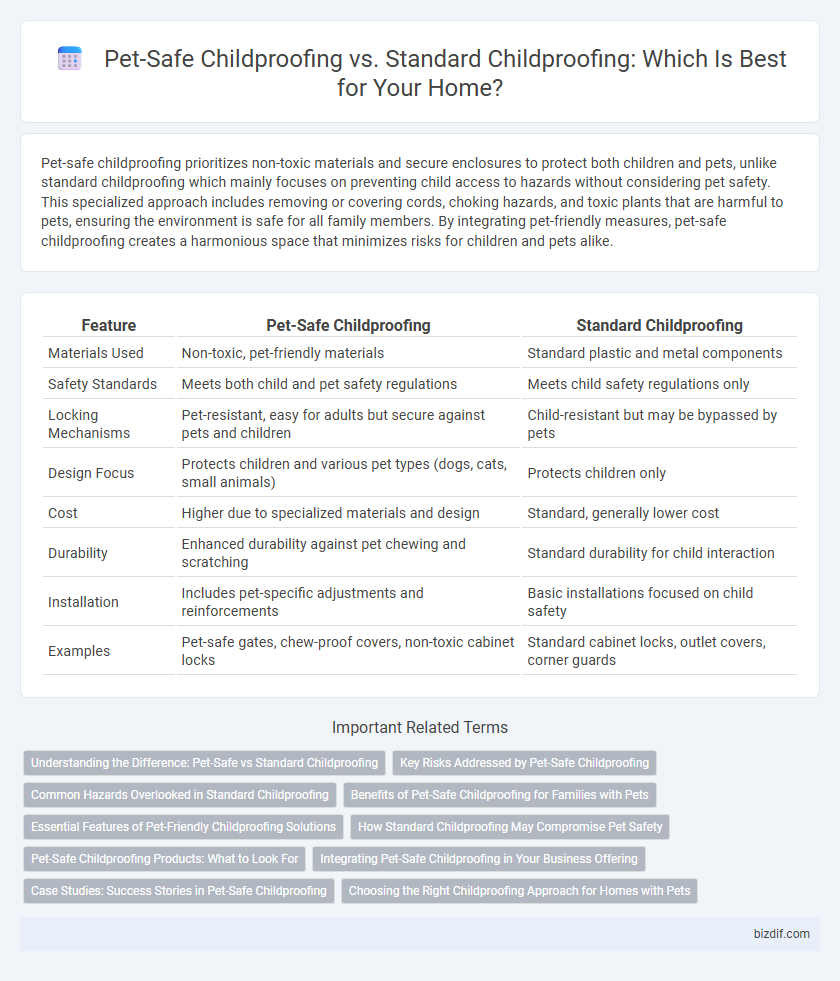Pet-safe childproofing prioritizes non-toxic materials and secure enclosures to protect both children and pets, unlike standard childproofing which mainly focuses on preventing child access to hazards without considering pet safety. This specialized approach includes removing or covering cords, choking hazards, and toxic plants that are harmful to pets, ensuring the environment is safe for all family members. By integrating pet-friendly measures, pet-safe childproofing creates a harmonious space that minimizes risks for children and pets alike.
Table of Comparison
| Feature | Pet-Safe Childproofing | Standard Childproofing |
|---|---|---|
| Materials Used | Non-toxic, pet-friendly materials | Standard plastic and metal components |
| Safety Standards | Meets both child and pet safety regulations | Meets child safety regulations only |
| Locking Mechanisms | Pet-resistant, easy for adults but secure against pets and children | Child-resistant but may be bypassed by pets |
| Design Focus | Protects children and various pet types (dogs, cats, small animals) | Protects children only |
| Cost | Higher due to specialized materials and design | Standard, generally lower cost |
| Durability | Enhanced durability against pet chewing and scratching | Standard durability for child interaction |
| Installation | Includes pet-specific adjustments and reinforcements | Basic installations focused on child safety |
| Examples | Pet-safe gates, chew-proof covers, non-toxic cabinet locks | Standard cabinet locks, outlet covers, corner guards |
Understanding the Difference: Pet-Safe vs Standard Childproofing
Pet-safe childproofing prioritizes non-toxic materials and secure designs that prevent pets from accessing harmful substances, unlike standard childproofing which primarily targets hazards for children without considering pet safety. This approach includes pet-friendly locks, coverings, and barriers that protect both children and animals while maintaining household functionality. Choosing pet-safe options ensures a safer environment by addressing the unique behaviors and risks posed by pets alongside childproofing needs.
Key Risks Addressed by Pet-Safe Childproofing
Pet-safe childproofing addresses unique risks such as exposure to toxic pet foods, chewing hazards from pet toys, and accidental ingestion of pet medications, which standard childproofing often overlooks. It ensures secure containment of cleaning agents and chemicals that could harm both pets and children. This specialized approach reduces choking hazards and prevents harmful interactions between pets and young children, creating a safer environment for all family members.
Common Hazards Overlooked in Standard Childproofing
Pet-safe childproofing addresses common hazards overlooked in standard childproofing by ensuring all materials and barriers are non-toxic and resistant to pets' chewing and scratching tendencies. Standard childproofing often fails to account for pet-related risks such as pet food consumption by children, unsecured pet medications, or escape routes pets might compromise. Incorporating pet-safe solutions reduces accidental poisoning, injury, and access concerns for multi-species households, enhancing overall home safety for both children and pets.
Benefits of Pet-Safe Childproofing for Families with Pets
Pet-safe childproofing uses non-toxic, pet-friendly materials and designs that protect children without exposing pets to harmful substances or hazards, ensuring a safer home environment. This approach reduces the risk of accidental ingestion or injury for both children and pets by securing areas with pet-accessible barriers and using chew-safe covers for electrical outlets and sharp edges. Families with pets benefit from tailored childproofing solutions that promote coexistence, prevent damage to belongings, and maintain overall household safety.
Essential Features of Pet-Friendly Childproofing Solutions
Pet-safe childproofing solutions incorporate non-toxic materials and secure designs that prevent access to hazardous areas without harming pets. Essential features include chew-resistant covers, secure cabinet locks safe for animals, and barrier gates with smooth surfaces to avoid injury. These solutions balance effective child safety measures while ensuring a pet-friendly environment free from toxic chemicals and potential pet hazards.
How Standard Childproofing May Compromise Pet Safety
Standard childproofing often involves the use of strong adhesives, chemicals, and small components that can pose choking hazards or toxic risks to pets, compromising their safety. Items such as baby gates or outlet covers designed without consideration for pets may trap or injure animals if they try to navigate or chew on them. Pet-safe childproofing prioritizes non-toxic materials and designs that safeguard both children and pets by minimizing hazards like harmful substances and entrapment risks.
Pet-Safe Childproofing Products: What to Look For
Pet-safe childproofing products prioritize non-toxic materials and secure, chew-resistant designs to protect both children and pets from harm. Look for safety gates with pet-friendly latches, cabinet locks made from BPA-free plastics, and corner guards that withstand pet scratching without compromising child safety. Choosing pet-safe options ensures a harmonious, secure environment, minimizing risks associated with common household hazards for households with both children and pets.
Integrating Pet-Safe Childproofing in Your Business Offering
Integrating pet-safe childproofing into your business offering enhances safety by addressing the unique needs of homes with pets and children, using non-toxic materials and pet-friendly locks. This approach minimizes risks from hazardous household items and pet interactions, ensuring a secure environment for all family members. Emphasizing pet-safe solutions differentiates your service and appeals to pet owners seeking comprehensive childproofing options.
Case Studies: Success Stories in Pet-Safe Childproofing
Pet-safe childproofing prioritizes non-toxic materials and pet-friendly designs to ensure the safety of both children and animals within the home environment. Case studies reveal that homes using pet-safe childproofing solutions report significantly fewer accidents involving pets and children, demonstrating effective prevention of hazards like chewing on electrical cords or ingesting harmful substances. These success stories validate the importance of specialized childproofing that accommodates pet behavior and promotes harmonious coexistence.
Choosing the Right Childproofing Approach for Homes with Pets
Pet-safe childproofing prioritizes non-toxic, durable materials and secure installations that prevent pet access to hazardous areas while ensuring children's safety. Standard childproofing primarily focuses on child access prevention without accounting for pet behavior or potential exposure to harmful substances. Homes with pets require customized solutions that balance protecting children from common dangers and safeguarding pets from childproofing devices, promoting a harmonious and secure environment.
Pet-safe childproofing vs Standard childproofing Infographic

 bizdif.com
bizdif.com